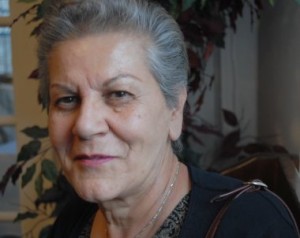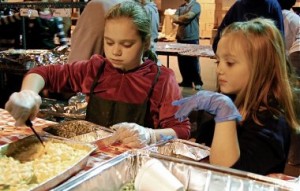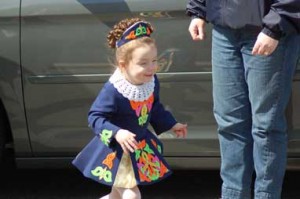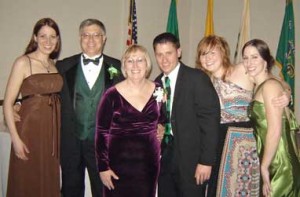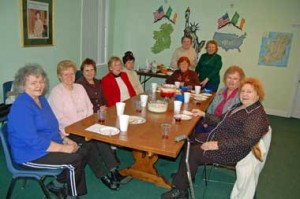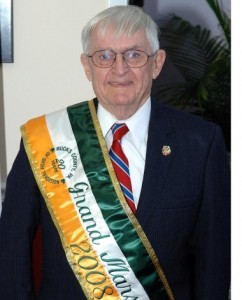What Hollywood calls the “biopic” –biographical films like the recent Johnny Cash-June Carter homage, “I Walk the Line”—tend to treat the facts of a life as though they were Silly Putty, not concrete. What’s ugly is gussied up; what’s pretty is sometimes muddied. The ordinary moments are edited for the sake of drama; the extraordinary, exaggerated for the same reason.
But those who knew Christy Brown—the severely disabled Dubliner who gained fame by using the toes of his left foot to write and paint—say his portrayal by Oscar-winning actor, Daniel Day-Lewis, in the movie “My Left Foot” was uncannily accurate.
“He completely did it,” says Siobhan O’Neill of Philadelphia, who grew up in the same Dublin neighborhood as Brown, a close friend of her parents, Hugh and Hyacinthe O’Neill. “As a little kid, I used to sketch and I would sit and study people. My mother would tell me to stop staring. But Christy would hold his hands in such a twisted way that I can’t even imitate it, and Daniel did it, not even knowing Christy. It was like he was channeling Christy.”
Day-Lewis also captured Christy Brown’s dark side. “He was very funny, a bit of a genius, in some ways great, but in other ways he was terrible,” says Hyacinthe O’Neill, who became close to the Brown family (“his sister Anne was my best friend”) as a 19-year-old engaged to Hugh O’Neill, a lifelong friend of Christy’s youngest brother. “A mind so active as Christy’s, being shut up in a body that doesn’t work was torture. He was depressed a lot which may be why he drank so much.”
Hyacinthe O’Neill will share her reminiscences of Christy Brown next Thursday night at 7:30 PM when The Irish Film Series at Philadelphia’s Irish Center, concludes with “My Left Foot.” And she will provide the disturbing epilogue to Jim Sheridan’s uplifting but unsentimental movie that ends with Christy lifting a glass of champagne with the woman who eventually becomes his wife, Mary Carr. Hyacinthe O’Neill and her daughter sat down at the Irish Center this week to talk to www.irishphiladelphia.com about their old friend, who died in 1981.
Hyacyinthe O’Neill, the daughter of a British Army officer and an Anglo-Indian missionary’s daughter, spent much of her childhood in India where she attended boarding school with Nepalese princesses and a Thai king’s son. After Indian independence, her father left the military and became a policeman in Scotland. O’Neill was living in London when she met Irishman Hugh O’Neill whom she married and with whom she had three children. She lived most of her adult life in Ireland, much of it in the Dublin neighborhood where the Brown family—Christy was the ninth of 13 surviving children—lived.
“His mother was a saint,” says O’Neill, who now lives in Mt Airy and works as an accountant for a Manayunk firm after years in a family business in London and California. Though Brown’s mother was told by doctors that her son was hopelessly mentally disabled, she refused to believe it. And when he picked up a piece of chalk with the only part of his body he could move—his left foot–and tried writing words on the floor, she began to teach him to both read and write.
“There were always tons of visitors at the Brown house and there was always a huge pot of stew on no matter when you went there,” O’Neill recalls. “She was a wonderful woman. I don’t know how she coped with such a huge family and a son who needed so much, but I never saw her lose her temper.”
Not so Christy. “Oh, he swore all the time,” says Siobhan, who works in the admissions office at the University of Pennsylvania. “He had little tolerance for fools, though he was always nice to kids. He really liked children. When we were little, there were always parties at Christy’s house. There were famous people there, like Peter Sellers and Richard Harris, but I guess we were too little to appreciate that. We were bored stupid by them. So we would go up to Christy and ask him if we could play with his wheel chair and he would say yes, and off we’d go, racing each other up and down the way.”
The O’Neills would often give the Brown family a much-needed break, and whisk Christy away to a nearby lake where he could paint. Or down to the neighborhood pub, The Stone Boat. “Christy loved to drink,” says Hyacinthe O’Neill. “There was very little else for him to do besides read.” They would also travel with him to the north side of Dublin to hear his favorite musical group, The Dubliners.
While the film of his life isn’t sugar-coated, it also celebrates Christy’s indomitable spirit—though he knew he would never live like a normal man, he was determined to wring everything out of life that he could. But the ending, which hints that Christy found both fame and the love of his life, says O’Neill, wasn’t truly the end.
“It was a horror story in the end. It was heartbreaking,” she says.
In the film, the nurse (called Julia) Christy meets and falls in love with was actually a former prostitute and lesbian named Mary Carr, once briefly a dental assistant who couldn’t hold a job because of her drinking and drug use, a claim made by a controversial biography, “Christy Brown – The Life that Inspired My Left Foot” by British author Georgina Hambleton, published last summer. Though the movie shows Christy and his future wife meeting at a gala event in his honor, in the book Christy’s brother Sean says that he introduced the two. Mary Carr, he says, was the lesbian lover of a friend.
“Oh, she was terrible,” says Hyacinthe O’Neill of Mary Carr Brown, who, like Christy, has since died. “But after he met Mary and married her, Christy was happy. She was not ideal, but he had a companion, someone to talk to. He influenced her to read and they could talk about books. Whether it was obsession, which is probably was, not love, right to the end, no matter what she did, he wanted to be with her.”
What she did, says O’Neill, besides having affairs with both men and women, was neglect her invalid husband, whom she hustled away to an ocean-front cottage in Kerry to keep him hidden from the prying eyes of his anxious family. “We went down there once and found Christy in his wheelchair perched at the edge of a cliff, looking out at the sea alone,” says O’Neill. “And he was emaciated. I don’t think he’d eaten in weeks. Sometimes she would lock him up in the house, leave him with bottles of whiskey and a straw, and go away for God knows how long.”
Yet, hospitalized by his family in Dublin for malnutrition, “he still wanted to go back to her,” says O’Neill. “He said if they didn’t take him back, he would crawl on his hands and knees to get back to her.”
In 1981, Brown choked to death while eating dinner. “All his food had to be cut up into very small pieces so he could swallow it,” explains O’Neill. “He choked on a piece of meat that was too big.” The implication remains unsaid.
After Christy’s death, O’Neill recalls, Mary threw out many of his paintings. Her husband, Hugh, was so disturbed by this that he went into the dumpster and rescued as many of them as he could. For years, the O’Neills kept them in storage. “They moved with us everywhere we went, including to California,” she says. “In the movie, all the paintings you see were the ones we rescued. Anne [Brown] told the producers that we had them, and they borrowed them.”
Unfortunately, all of these early works were all lost when a friend of the O’Neills, a German art conservator who was in the middle of restoring them, died of a heart attack. “We don’t know where they ended up,” she says.
Although the O’Neills, like Christy’s family, believe Mary Carr’s neglect led to his untimely death at 49, they also believe—hope really—that his love for her, however unwarranted, was a source of his happiness to the end. “He was happy with her and he was happy when they moved to Kerry,” says Siobhan O’Neill. “Hopefully, he died happy.”
“My Left Foot” will be shown at the Irish Center, Carpenter and Emlen Streets, in the Mt. Airy section of Philadelphia, on Thursday, May 1, at 7:30 PM. Hyacinthe O’Neill will introduce the film and answer audience questions. The Irish Film series was jointly sponsored by The Irish Center, WTMR radio host Marianne McDonald, and www.irishphiladelphia.com. Refreshments are available for purchase.

